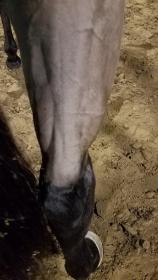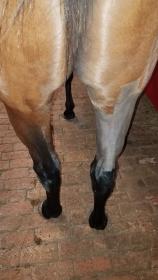I haven’t dealt with horses or nuclear bone scan professionally in years, and it wouldn’t be appropriate to comment on a specific case’s medical status in this kind of situation, anyway. But, I can give some general education on why a lesion might be cold on the soft tissue and hot on the bone phase (of a bone scan, there’s a lot of other kinds of nuclear scans that aren’t done commonly in horses that radically change what kind of soft tissues are hot).
Soft tissue pathology is hot if it has a higher blood flow than the soft tissue in the area would have normally. Usually that means active, acute, inflammation, the same kinds of things you would expect to perhaps be literally HOT/warm if you passed your hand over them. Sometimes it means something like a vascular malformation, but that’s pretty rare.
In the bone phase, the body has incorporated the radioactivity (slang term in my world is “tech” to shorten “technetium 99m”) into the body the same way (roughly) it does phosphorous, and it’s built in to any hydroxyapatite crystals (the Lego bricks that make bone) the body is busy making since the injection happened. The body mostly is busy making HA crystals in bone. There’s plenty of it in teeth, too, but teeth don’t have a lot of turnover like bone does, so they’ll be pretty cold unless there’s something wrong. Normal warm-to-hot areas are places where the major weight bearing forces occur, and physes in youngsters. There’s also a relative appearance of warm vs cold depending on how much tissue is overlying the area. Abnormal spots are where the body is putting down more HA crystals than normal. Usually it’s a site of bony remodeling, like arthritis, navicular disease, stress fracture, osteomyelitis. However, there are certain soft tissue conditions that will have mineral and they will “light up” too. General (very general) classifications that may be seen (considering all species, not just horses) are sites of chronic inflammation or previous injury/insult (which may not be active enough to light up on the ST phase) developing “dystrophic mineralization”, oddball disorders of calcium/phosphorous metabolism like calcinosis circumscripta or calcinosis cutis, general disorders of Ca/Ph metabolism like parathyroid disease, and neoplasms (both benign and malignant) that have a tendency to lay down mineral (extraskeletal osteosarcoma, certain types of mammary and urinary tract tumors, etc).




